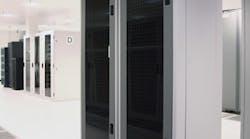A measure of a facility's total power delivered divided by its IT equipment power usage level, power usage effectiveness (PUE) is especially important in data centers. For starters, these energy-intensive buildings are growing at a rapid pace, consuming 10 to 100 times more energy per square foot than a typical office building. In 2006, for example, data centers used more than 60 billion kilowatt-hours, a number that some industry experts expect will increase to 100 billion kilowatt-hours by 2011.
Total facility power is defined as the power measured at the utility meter (i.e., the power dedicated solely to the data center). This is an important factor in “mixed-use” buildings that house data centers, as this is only one portion of the overall load of the facility. If the data center is not wired on a separate utility meter, estimate the amount of power being consumed by the non-data center portion of the building and subtract this value from the equation (PUE = total facility power 4 IT equipment power). Following is a list of total facility power-related components (i.e., typically power distribution-related equipment):
UPS modules
Switchgear
Generators
Power distribution units (PDUs)
Batteries
Lighting
Distribution losses external to the IT equipment
Total facility power loads also include cooling system components, such as:
-
Chillers
-
Computer room air-conditioning (A/C) units (CRACs)
-
Direct expansion air handler (DX) units
-
Pumps
-
Cooling towers
IT equipment power is defined as the devices used to manage, route, store, or process data within a data center. The load components under the IT equipment power heading include:
-
Computers (desktop, workstation, and laptop plus servers)
-
Storage devices (drives, tape, mass media)
-
Network equipment
-
Supervisory equipment such as KVM switches and monitors
These power measurements provide a baseline that allows an IT facility manager to compare his or her power usage levels to other data centers. Typical components found in a data center are shown in Fig. 1.
How do you measure IT equipment power? Measure the IT equipment load after power conversion, switching, and conditioning is completed. According to The Green Grid, a global consortium based in Beaverton, Ore., that is dedicated to advancing energy efficiency in data centers and business computing ecosystems, the most useful measurement point is at the output of the computer room PDUs. This measurement should represent the total power delivered to the server racks in the data center.
What is a good PUE rating? The Green Grid has defined a PUE rating of 1.0 equivalent to a 100% efficient facility. A small study by Lawrence Berkeley National Labs, “Best Practices for Data Centers: Lessons Learned from Benchmarking 22 Data Centers,” found that the data centers it studied had a PUE range of 1.3 to 3.0. According to The Uptime Institute, an industry provider of vendor-neutral, research-based information on high-density enterprise computing based in Santa Fe, N.M., the typical data center has an average PUE of 2.5.
What does this ratio truly mean? It means that for every 2.5W of input at the utility meter, only 1W of output is delivered to the connected IT load. The Uptime Institute estimates that most facilities could achieve a PUE rating of 1.6 by using the most efficient-equipment available and following industry best practices.
Is PUE a dynamic value? In reality, PUE is a dynamic number that changes as the load changes in a data center room. How ironic would it be if the best PUE number attainable is when all the servers in the center are running at near capacity, and shutting down servers to save power actually increases the PUE value? Or your energy-efficient cooling system uses large amounts of water in Southern California where it's just a matter of time before water shortages will cause more environmental issues?
The quality of the electrical and mechanical systems and their operations over time are inputs into PUE. As load changes and servers are turned off, the variability of the power and cooling systems influences your PUE. Therefore, PUE can now have a statistical range of operation given the conditions. PUE should be reported as a range of numbers (low to high), and the average calculated over a period of time. For example, Microsoft shows its PUE for one facility in Fig. 2.
Looking at the big picture, UPS systems operating with an energy efficiency rating in the mid 90% range while protecting critical loads are expected to become the norm. Data center facility managers monitor UPS efficiency more closely in the months and years to come to drive their PUE number down closer to 1.0.
Szalkus is a manager with GE Digital Energy - Power Quality, based in Lombard, Ill. He can be reached at [email protected].



